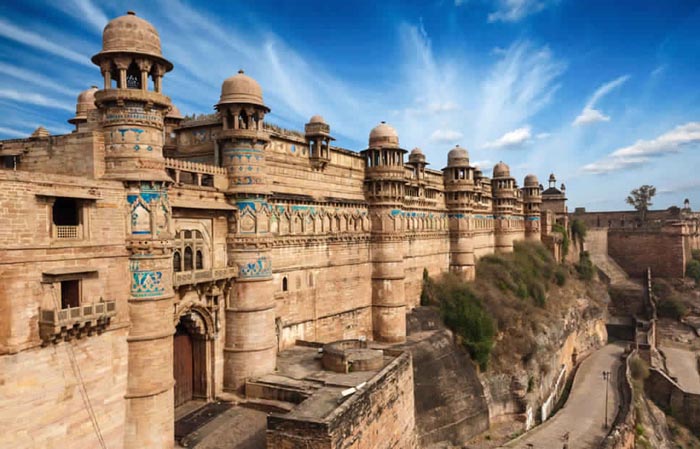Gwalior Fort

Information on Gwalior Fort (Gwalior, Madhya Pradesh) - History & Architecture
The Gwalior fort is an ancient fort with records dating back to 525 AD however the construction of the palace inside it was brought about by Man Singh Tomar during the 8th century. The fort is one the best architectural structures of the 8th century and consists of a defensive structure with two palaces within it. The two palaces that are inside the fort are known as the Gurjari Mahal and Man Mandir. The fort and one of its palaces namely the Gurjari Mahal was built specifically for Queen Mrignayani however with the passage of time it as served as a stronghold for many other rulers.
Gwalior Fort Architecture
This monument is one of the most well maintained forts and palaces in all of India. Fort encloses within it palaces, temple and water tanks which are architectural marvels that will keep one spellbound. The fort encompasses within itself an area of 3 sq. kilometres and is 35 meters in height. The rampart of the fort has been built along the edge of the hill and is connected with the means of 6 towers. There are two entrances to the fort, one is the Hathi Pul which is the main entrance and the other one is the Badalgarh gate.
The main gate or the Hathi Pul is ornately carved and has a series of seven gates. The name Hathi gate comes from an elephant statue that once was at the gate. The gate with its stone carved cylindrical towers with domes linked by parapets is a marvel of architecture that one must see.
The palaces within the fort are also well decorated and carved. The Man Mandir palace is one of the most ornately carved and decorated palaces in the fort. Other than the forts the temples dedicated to Gautama Buddha and the tirthankaras of Jainism are also of great architectural value.
Other monuments of architectural and structural significance that adorns this fort with their marvellous carvings and designs are Vikram Mahal, Chhatri of Bhim Singh Rana, Garuda Monument and the Saas-Bahu temple etc.
Gwalior Fort History
This particular fort is a very old one with records of it dating back to the 5th century AD. The name Gwalior, according to legends comes from the name of a hermit (Gwalipa) who gave a chieftain called Suraj Sen Kachwaha healing water which cured his leprosy.
The first known rulers of the area were of the Pal dynasty who then passed it on to the Pratihara dynasty. The fort was the seat of rule for both the dynasties however the most widely known patron and builders of the fort belonged to the Tomar Dynasty.
The fort was under the rule of the Tomar's from the year 1398 - 1518 and the most well known ruler to be associated with its construction is Man Singh Tomar. He was the one to construct the Man Mandir Palace and the Gurjari Mahal. The Gurjari Mahal was built specifically for Queen Mrignayani whom Man Singh Tomar was trying to win over. It is said that the Queen after being won by him asked for a separate palace to stay in and thus the Gurjari Mahal was built.
After the Tomar's the fort was captured by Ibrahim Lodi in the year 1519, then after it was overtaken by the Mughal emperor Babar who then passed it onto his son Humayun who lost it to Sher Shah Suri. The Gwalior fort is also where the executions of the Mughal emperor Akbar's cousin Kamran, Aurangazeb's brother Murad and his nephews took place.
Once the Mughal and Suri rule was over the fort fell into the hands of the Rana Jat Dynasty (1740-1783), then the Marathas and finally came under the British Government.
The famed rebellion of 1857 which played an important role in the struggle for Indian independence was started here by Rani Laxmi Bai. She however was defeated by General Hugh Rose and his Central India Field Force who took over the fort in 1858.
Gwalior Fort Tourism Importance
The historical and cultural influence of this particular fort is a great one and therefore tourists visiting Gwalior never miss out on it. The paintings and architectural marvels that one can witness here is simply awe inspiring.
- Andaman Nicobar Monuments
- Andhra Pradesh Monuments
- Assam Monuments
- Bihar Monuments
- Chhattisgarh Monuments
- New Delhi Monuments
- Goa Monuments
- Gujarat Monuments
- Haryana Monuments
- Himachal Pradesh Monuments
- Jammu and Kashmir Monuments
- Karnataka Monuments
- Kerala Monuments
- Madhya Pradesh Monuments
- Maharashtra Monuments
- Odisha Monuments
- Punjab Monuments
- Rajasthan Monuments
- Tamil Nadu Monuments
- Telangana Monuments
- Uttar Pradesh Monuments
- West Bengal Monuments